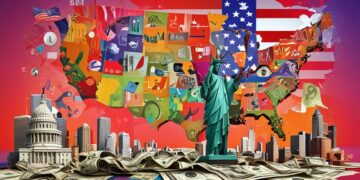The main financial and economic events in the US to watch.

Understanding Key Financial Events
Every year, the U.S. economy is shaped by significant financial and economic events that can influence markets and consumer behavior. These events hold immense power to sway investors’ decisions, impact corporate strategies, and ultimately shape the financial landscape that affects everyday consumers. Staying informed about these events is essential, as they provide valuable insights into the potential direction of the economy and individual financial decisions.
Key events to watch include:
- Federal Reserve Meetings: The Federal Reserve, often referred to as the Fed, holds meetings regularly to discuss monetary policy, including adjustments to interest rates. A decision to raise interest rates typically makes borrowing more expensive, affecting everything from mortgage payments to credit card interest. For example, if the Fed raises rates, individuals looking to buy homes may face higher monthly payments, possibly reducing their purchasing power and dampening the housing market.
- Quarterly Earnings Reports: Major publicly traded companies release quarterly earnings reports, providing a glimpse into their financial health and performance. These reports can greatly influence stock prices and market trends. For instance, if a major tech company reports earnings that exceed analyst expectations, its stock may surge, reflecting optimism in the sector. Conversely, disappointing results can lead to a swift decline in stock prices, impacting investor confidence across the market.
- Economic Indicators: Indicators such as unemployment rates, inflation, and GDP growth are critical in assessing the economy’s overall health. For example, a drop in unemployment rates typically signals a robust economy, potentially leading to increased consumer spending, as more individuals are earning wages. On the contrary, rising unemployment could trigger concerns about economic stability, thereby affecting investment strategies and consumer confidence.
- Major Government Policies: Changes in trade agreements or fiscal policy can have far-reaching effects on the economy. For instance, the implementation of tariffs can affect import prices, influencing the cost of goods for consumers and impacting domestic manufacturers. Likewise, government stimulus packages aimed at boosting the economy during downturns can provide consumers and businesses with the support needed to navigate challenging times.
Each of these events provides unique insights and can dramatically affect investments and the overall economy. By understanding the implications of these occurrences, both seasoned investors and everyday consumers can make more informed financial decisions.
Grasping what these events mean and how their outcomes can affect your financial priorities is crucial for navigating the current economic landscape. Whether you’re planning to invest, expand your business, or make a significant purchase, staying alert to these key financial events will equip you with the knowledge necessary to anticipate market shifts and adjust your strategies accordingly.
SEE ALSO: Click here to read another article
Key Economic Indicators to Monitor
Among the various financial events, economic indicators play a vital role in evaluating the current state of the economy. These indicators provide a snapshot of economic performance and can help predict future trends. Investors, policymakers, and everyday citizens should pay close attention to the following indicators:
- Unemployment Rate: The unemployment rate is a key measure of economic health, reflecting the percentage of the labor force that is unemployed but actively seeking work. A declining unemployment rate generally signifies that the economy is expanding, leading to increased consumer confidence and spending. For instance, if the unemployment rate drops to a historically low level, we may witness greater consumer spending and higher demand for goods and services, boosting businesses and potentially prompting companies to expand.
- Inflation: Inflation rates indicate how much prices for goods and services have increased over time. Measured by the Consumer Price Index (CPI) or the Personal Consumption Expenditures (PCE) index, inflation influences purchasing power. If inflation rates rise significantly, consumers may find their dollar doesn’t go as far, potentially leading to decreased spending. Conversely, stable inflation can foster a favorable environment for economic growth, encouraging investment and consumption.
- Gross Domestic Product (GDP): GDP measures the total value of all goods and services produced in the U.S. and serves as a broad indicator of economic activity. A growing GDP indicates a healthy economy, while a shrinking GDP can signal a recession. For example, if GDP growth hits a consistent annual rate of 3% or higher, businesses and investors may view this as a signal to invest and expand, anticipating ongoing economic strength.
- Consumer Confidence Index (CCI): This index gauges how optimistic or pessimistic consumers feel about the economy’s current and future prospects. High consumer confidence often correlates with increased spending, while low confidence may lead to cautious consumer behavior. For instance, if a sudden drop in CCI occurs, it might indicate that consumers are tightening their budgets, prompting businesses to reconsider their sales forecasts and investment strategies.
Understanding these economic indicators is essential for interpreting the health of the economy and making better financial decisions. Whether you are a seasoned investor analyzing market conditions or an everyday consumer deciding on a major purchase, these metrics provide critical insights into economic trends that can impact your financial landscape.
By tracking these key indicators, individuals can better prepare themselves for potential changes in the economic environment. Recognizing the patterns in unemployment, inflation, GDP, and consumer confidence can empower you to respond thoughtfully to shifts in the economy, whether that means altering your investment strategy or adjusting your personal budget.
CHECK OUT: Click here to explore more
Key Financial Events and Reports
In addition to economic indicators, several financial events and reports can provide significant insights into the health and direction of the U.S. economy. Investors and analysts closely monitor these events, as they often have far-reaching implications for market trends and investment strategies. Here are some of the key financial events and reports to keep an eye on:
- Federal Reserve Meetings: The Federal Reserve (often referred to as the Fed) significantly influences monetary policy in the United States. Meetings are held approximately every six weeks, where policymakers assess economic conditions and decide on interest rates. Changes in interest rates can sway consumer borrowing costs, impact business investments, and, in turn, affect overall economic activity. For example, when the Fed raises interest rates to combat rising inflation, borrowing becomes more expensive, which could lead to slower spending and investment. Conversely, lowering rates can encourage borrowing, stimulating economic growth.
- Corporate Earnings Reports: Earnings season, which occurs quarterly, is marked by companies releasing their financial results and forecasts. These reports offer a glimpse into the profitability of various sectors and play a crucial role in influencing stock prices. Positive results can lead to increased investor confidence and might boost stock market performance. Alternatively, if several prominent companies report disappointing earnings, it could raise concerns about economic slowdown and result in broader market declines.
- Consumer Spending Reports: As consumer spending accounts for a substantial part of the U.S. economy, monitoring retail sales data is critical. Regular reports provide insights into consumer behavior, indicating whether people are willing to spend money on goods and services. If retail sales increase, it often signals economic strength, while a decline could suggest that consumers are becoming cautious. For instance, higher sales during holiday seasons can point to optimism, encouraging businesses to stock up and hire more employees.
- Trade Balance Reports: The trade balance measures the difference between a country’s exports and imports. A trade deficit occurs when imports exceed exports, while a surplus happens when exports are higher than imports. Monitoring the trade balance is important as it can have implications on currency value and the overall economic outlook. A growing deficit, for instance, may indicate decreased demand for U.S. products abroad or increasing dependence on foreign goods, which can affect job growth and economic stability.
Paying attention to these financial events and reports can equip individuals and businesses with a better understanding of the market dynamics. Each piece of the puzzle contributes to a larger picture of economic health and potential fluctuations in the market landscape.
Moreover, understanding the interconnectedness of these events allows for deeper insight. For example, how corporate earnings affect consumer spending or the possible repercussions of Federal Reserve policies on trade balances can create a complex web of influences. By staying informed, you can prepare for changes, adapt strategies effectively, and enhance your financial acumen in an ever-evolving economic environment.
SEE ALSO: Click here to read another article
Conclusion
In summary, keeping a close watch on financial and economic events is essential for anyone looking to navigate the complexities of the U.S. economy. Events such as Federal Reserve meetings, corporate earnings reports, consumer spending data, and trade balance statistics all play pivotal roles in shaping market dynamics. Each indicator provides valuable insights into economic health and potential future trends, allowing investors and businesses to make informed decisions.
To illustrate this point, consider the Federal Reserve meetings, which are critical occasions where policymakers discuss interest rates and monetary policies. A decision to lower interest rates can make borrowing cheaper, encouraging both consumer spending and business investment. For example, a lower mortgage rate means that more people can afford homes, leading to increased activity in the housing market. In contrast, if the Fed raises rates, borrowing becomes more expensive, often leading to decreased consumer spending and a slowdown in economic growth.
The significance of corporate earnings reports cannot be underestimated either. These reports reveal how well companies are performing financially and can greatly affect stock prices. For instance, if a major company like Apple exceeds earnings expectations, this can lead to a surge in its stock price and potentially influence related sectors in the technology industry. Investors often use these reports to gauge overall economic sentiment and to adjust their portfolios accordingly.
Understanding the Interplay of Economic Indicators
Importantly, the interplay between these events is what truly influences financial landscapes. A shift in interest rates by the Federal Reserve can alter consumer spending patterns, while a deficit in trade balance may lead to lower corporate profitability for companies reliant on imports. For example, if the trade balance reflects more imports than exports, it might indicate that domestic producers are struggling to compete, which could depress stock prices across several sectors.
By recognizing these connections, stakeholders can gain a deeper understanding of the broader economic narrative. As we approach uncertain times influenced by various global factors, being proactive and informed can empower individuals and companies to adapt their strategies effectively. Staying updated on key financial events and metrics enables better preparation for market changes, allowing for the mitigation of potential risks and the capitalization on emerging opportunities.
Overall, cultivating an awareness of these economic indicators will not only enhance your financial literacy but also contribute to a more stable financial future. For instance, by understanding consumer spending data, a small business might adjust inventory levels to align with predicted seasonal buying behaviors. In essence, informed individuals and businesses are better positioned to thrive in a continuously evolving economic landscape.

Beatriz Johnson is a seasoned financial analyst and writer with a passion for simplifying the complexities of economics and finance. With over a decade of experience in the industry, she specializes in topics like personal finance, investment strategies, and global economic trends. Through her work on World Information, Beatriz empowers readers to make informed financial decisions and stay ahead in the ever-changing economic landscape.





